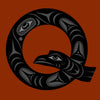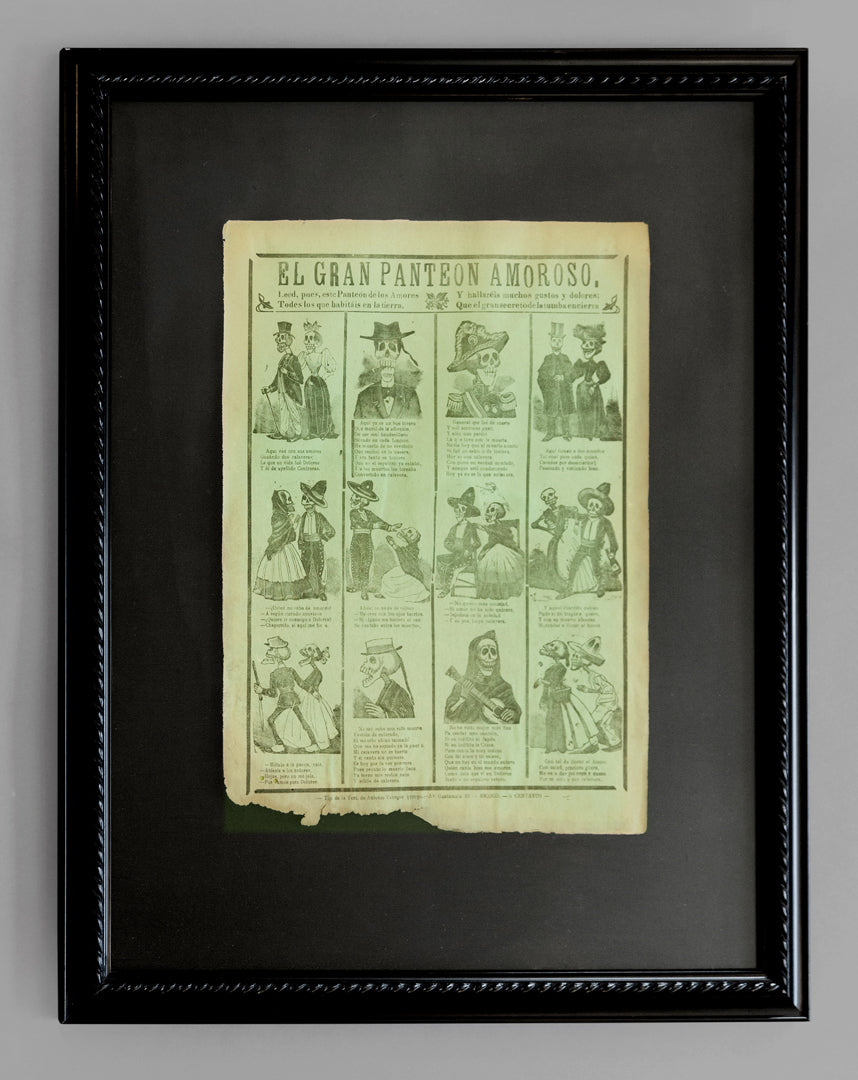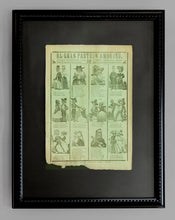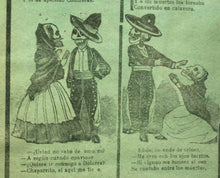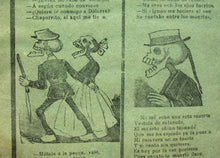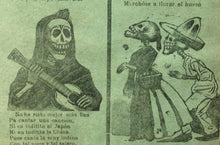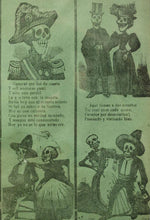El Gran Panteon Amoroso, c. 1900 by Jose Guadalupe Posada (1852-1913)
Regular price
$500.00
Sale
El Gran Panteon Amoroso (The Great Cemetery of Love), c. 1900
by Jose Guadalupe Posada (1952-1913)
original broadside
16" h x 12" w paper size
25"h x 20" w framed
Floated on archival black linen mat, black wood frame
This 120 year old broadside illustrates various calavera couples that are featured in this corrido. A corrido is a popular narrative tale and poem that forms a ballad. Traditionally Mexican corridos are often about oppression, history, daily life, and other socially relevant topics. They often poke fun at serious subjects, and in the day were considered subversive or contraversial.
The artist José Guadalupe Posada was born in 1852 in Aguacalientes, Mexico. Many consider Posada the founder of modern Mexican art. As well, Posada is credited with educating the general populace concerning the political injustices of the day which ultimately culminated in the Mexican Revolution of 1910. His beginnings were humble, being born the seventh son to working-class parents of Indian descent.
Posada is most remembered for his engraved illustrations of calaveras (skeletons) set in political satire. His work remains vital today, oftentimes utilized to commemorate the Dia de los Muertos (Day of the Dead) holiday, celebrated throughout Mexico each year on November 1st and 2nd.
Posada's talent was recognized at an early age. He became an apprentice to the printer and publisher Jose Trinidad Pedroza at the age of 16. It was under his mentor's tutelage that he learned the art of printmaking which focused on lithography as well as engraving on wood and metal. The shop where he worked, El Esfuerzo, located in the city of Aguascalientes also served as a meeting place where members of the community would discuss political and social issues of the day. This environment that Posada found himself in undoubtedly helped shape his political opinions and ultimately, his art.
Posada's work drew controversy almost immediately. Pedroza assigned the young artist to engrave a satirical cartoon of a local politician and needless to say, the response from the authorities was not favorable. His caricature was so compelling and created such an uproar that both teacher and student had to flee town to escape the wrath of those offended. Posada's career had begun.
Soon established in his new city of Leon, Posada's work began to appear in magazines. Some of these early works were political in nature but not all. Posada's other avenues of output included making artwork for purely commercial purposes, such as providing illustrations for matchbox covers, designing logos or engraving book cover designs. Posada married and began teaching lithography at a local school. Busy and fulfilled, his life went on uninterrupted until the year 1888, when a traumatic flood occurred in the city and posada was again forced to relocate.
Mexico City became Posada's new place of residence. He set up his own shop and worked for a variety of publishers on a free-lance basis. The artist forged an important liaison with Antonio Vanegas Arroyo, the leading publisher in the city. Together they created "hojas volantes"(flying leaves) which were one-page papers or broadsheets, distributed on the city streets for a penny a piece. These printed one-page documents covered a whole host of topics, ranging from moral stories to high-society gossip to songs that were illustrated (corridos).
Increasingly, Posada turned to the symbolism of the calavera (skeleton) to depict his illustrations that were filled with political satire. The dictatorship of Porfirio Diaz was in full swing at this time and social injustices were rampant. The decision to utilize skeletons in his illustrations had a two-fold effect. Graphically speaking, these images jump off the page, so to speak and cannot be ignored. As well, the people responded to the symbolism of the calavera as it was a deeply ingrained in their culture and subconscious. After all, the blood of their ancestors still ran in their veins, blood that was indigenous and not European. Many pre-Columbian civilizations decorated temples with skulls and had a deep fascination with death. While perhaps macabre on its surface, the symbolism of the calavera, which is in essence death, was a reminder that physical life is temporal while the spirit is eternal. Additionally, Posada's intent was to show that in death everyone is equal, despite one's economic position in life or status, death is the great equalizer that spares no one.
Another illustrator that worked in Arroyo's shop, Manuel Manilla, also utilized the symbolism of the calavera in his engravings. Together with Posada's prodigious contributions, the amount of calaveras (skeleton illustrations) this group produced was enormous and became very popular with the masses. Although many people were illiterate, they could still "read" what the illustrations were saying, a tribute to their effectiveness. As the often quoted saying goes "...a picture says a thousand words....".
Posada was extremely prolific with the amount of work he produced in his life. Although the true number of engravings he made cannot be ascertained, some place the number as high as 20,000 works. Of these, it has been reported that an estimated 2,000 engravings have survived.
Undoubtedly, a technique that Posada invented helped him enormously both in production as well as expression. Well acquainted with the traditional printmaking technique of lithography, Posada also worked on wood blocks as well as zinc plates. Interested, however, in increasing his output, his experimentations led him to a new technique. Using acid-resistant ink, he would draw directly onto the metal plate and then place the plate in an acid-solution that quickly embedded the drawing. This plate, in turn, could be placed on the printing press at the same time as the type was placed, thereby saving an enormous amount of time and increasing production.
Posada's new technique developed just prior to the Mexican Revolution of 1910. The output dramatically increased at Arroyo's shop and the one-cent papers were being widely distributed on the streets of Mexico City. Posada's illustrations have been credited with raising awareness enormously concerning the political injustices and abuses of the day. While he diligently worked from dawn to dusk, Posada was contributing greatly to the work of the revolutionaries who sought justice from the evils of Porfirio Diaz's dictatorship.
As well, Posada played a pivotal role in the development of Diego Rivera's work. Rivera was inspired by Posada's attention to working-class concerns as well as his expressive artistic technique. While attending the San Carlos Academy of Art in Mexico City, Rivera would often stop by to visit Posada and watch him work. Years later, Rivera credited Posada as having been a great influence on his own artwork and direction. One of Rivera's famous paintings, "Dream of a Sunday Afternoon in Alameda Park" pays a visual homage to Posada. Rivera included the famous skeleton image of the “catrina” that Posada so often employed, a symbolic representation of a typical society-woman from turn-of-the- century Mexico.
In addition to Rivera, Posada proved an inspiration to Jose Clemente Orozco, who as a boy would visit Posada in his workshop. In his autobiography, Orozco writes, "This was my awakening to the existence of the art of painting. I became one of the most faithful customers in Vanegas Arroyo's retail shop . . . ." Posada's influence was so great and he influenced so many that somehow it doesn't seem right that the artist died in obscurity and poverty. He died quietly in the year 1913, alone and penniless and was buried in a common grave.
Some years later, a French artist by the name of Jean Charlot was collaborating on a mural with Diego Rivera in Mexico City. Charlot, walking the streets of the city, came upon Posada's work which was still being used to illustrate the daily one-cent papers. Deeply intrigued and interested, Charlot began to feverishly collect Posada's work. As well, he published an article about Posada that was widely read and admired. Charlot proved instrumental in bringing international awareness to the importance of Posada's work and his place in history.
Today, Posada's work is housed in various collections throughout the world. A museum dedicated to the artist is located in Posada's hometown of Aguascalientes, Mexico. The Museo Jose Guadalupe Posada features prints along with the original metal plates that were used to create them. Although Posada the man is deceased, his work lives on, perhaps the greatest triumph over death there is.
